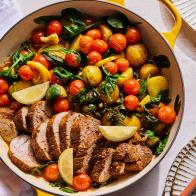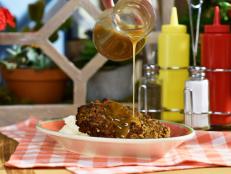Kitchen Helpline -- Shopping
Once again, we've opened our Kitchen Helpline, and this time we've got the answers to your pressing questions about buying chicken. Here's what you want to know!

Question 1: The labeling on chicken can be a bit confusing. What should I really be buying?
There are many different labels for chicken in your butcher's case, and deciphering them can certainly make your head spin. We at The Kitchen like to keep 3 things in mind: what to "Look for," what to "Ignore" and what to "Avoid."
LOOK FOR the "organic" label. The organic chicken label means that the chickens were fed with food that contains no chemical fertilizers, pesticides or other additives. Organic poultry must also meet free-range requirements, meaning the birds have access to the outdoors.
Also LOOK FOR the "air chilled" label. During typical chicken processing, chickens are immersed in a cold-water bath to cool them down quickly. This cooling technique causes them to absorb additional water. When you buy these chickens, you're paying more for additional water weight. With air-chilled chickens, cold air is used to quickly bring down the temperature of the chickens before packaging. While these chickens cost a little more, the meat is denser, juicier and more flavorful. You pay for all meat with no additional water.
Some labels are simply used for marketing. Here's what you can IGNORE: "Natural," because the label has nothing to do with the way the chicken was raised. Natural simply means that no additives or preservatives were introduced after the poultry was processed. Also IGNORE the "hormone free" label. In the US, no chickens are allowed to be injected with hormones, so all chickens should be hormone free. Finally, IGNORE the label "farm raised". Unless it's identified as a local farm, this label is all marketing. Almost all chickens are raised on a farm of some kind.
Here's what you can AVOID altogether. Stay away from "enhanced" chicken, which is chicken pumped with salt water or chicken stock to keep it plump and juicy. This can add up to 5 times more sodium to your chicken than it would have naturally. About 30 percent of store-bought chicken is enhanced with some sort of liquid before sale. If you do end up buying this type of chicken, adjust the salt in your recipe since it is already somewhat seasoned.
Question 2: Which parts of the chicken are best for which meals/recipes?
Chicken breasts: "Like a pair of black pumps. They go with everything." Breasts are white meat, very mild and take well to any flavored sauce. Try grilling them, cooking them up in stir-fry or even pan roasting. Breasts are also perfect for poaching or slow cooking. Cooking with these methods creates tender shredded chicken for salads, sandwiches or tacos. Breasts are most often found skinless and boneless--making prep a little easier--but bone-in and skin-on breasts are less expensive, and the bones and skin add flavor while cooking, which should also be considered when you're making your selection.
Chicken thighs "do all the heavy lifting," literally! Because they are dark meat, they have a richer, fattier chicken flavor. Thighs are great on the grill, baked and braised. Their higher fat content makes them the perfect choice for the slow cooker. Like breasts, you will find thighs with or without the bone. The bone-in variety is less expensive and gives more flavor to your dish when cooked.
PRO TIP: Ask your meat counter person to grind chicken thighs for you. They make great meatballs and meatloaf.
Drumsticks are the "perfect portion." They too are dark meat and have a similar flavor to the thigh. You can fry, roast or grill them, and they take well to flavorful sauces. They are also inexpensive--making it easy to feed a hungry crowd at a backyard barbecue without breaking the bank.
We all know wings are "ready to party!" They are tender and delicious whether fried, roasted or grilled. Whole chicken wings are sold intact (which are best when grilling) or they can be separated into flats and drumettes, with the wing tip removed. If you're breaking down the wings yourself, don't discard the tips. Throw them in a freezer bag and use them to make homemade stock!




























































































